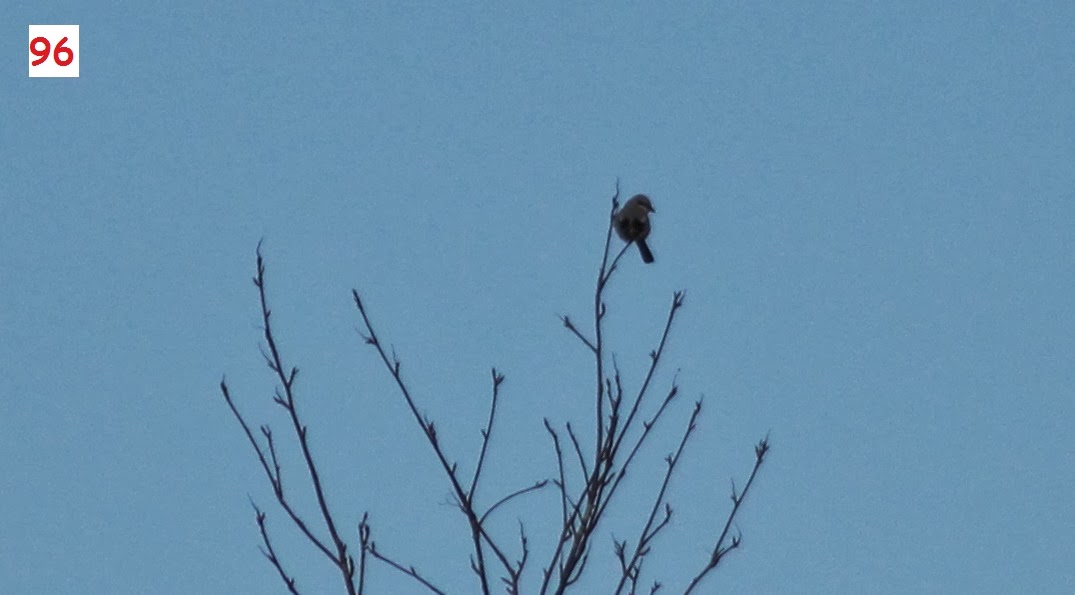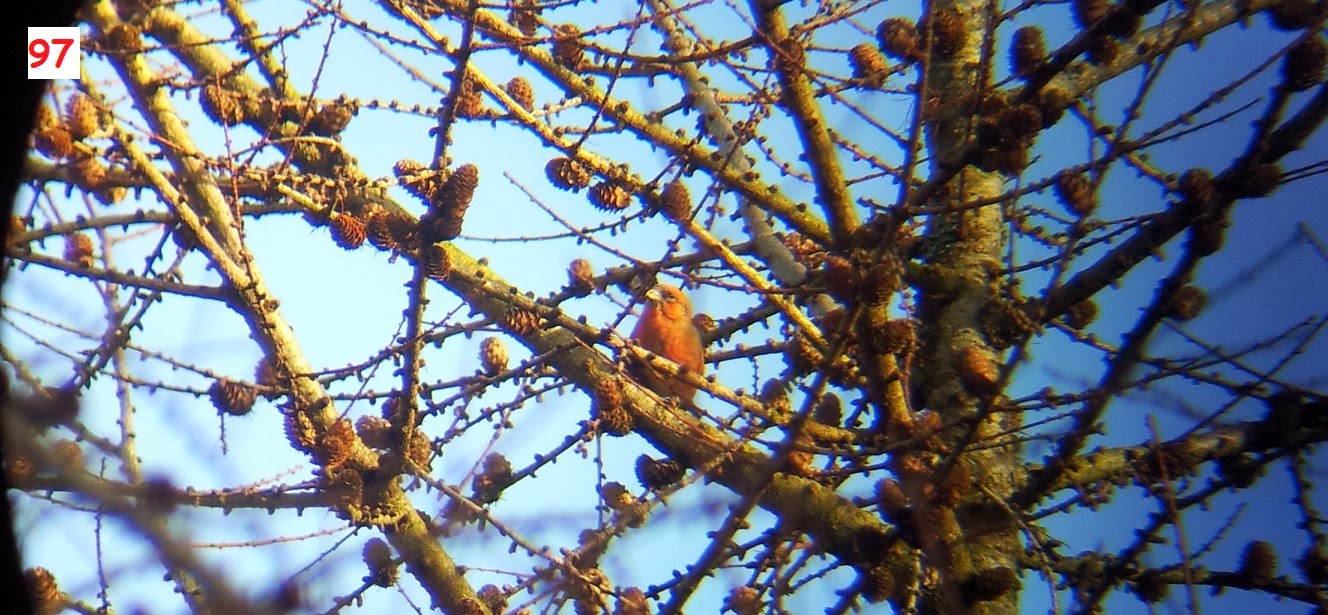We arose nice and early this morning but didn't need to overly rush as there was not commute to consider, the first port of call was the beach across the road. It was still the beginnings of dawn when we hit the sand dunes. The 4 of us spread ourselves in an extended line and started walking towards the area for which the majority of sighting reports were about to see if any of us could locate the Shorelark we were looking for last night. After about an hour having walked up and back down the beach along both the sand dunes and the shoreline, we bumped into a local birder who had seen them, he informed us that they'd flown in our direction but we had neither seen nor heard them. During our hunt for the Shorelark we had a flock of 8
Snow Bunting fly over, they were very skittish, I managed to follow one to ground but only at distance, any time I attempted to approach by even a few meters it would move along so this was the best shot I could manage, not very good I'm afraid but you tell it's a Snow Bunting.
114. Snow Bunting
We did have some great views of
Mediterranean Gull flying along the coast line with some great overhead views, additionally there were plenty of
Lesser Black-backed Gull and
Herring Gull. We were treated some great views of Grey Seal again, I couldn't believe how close the be tide line it was, I think he was just curious as to what was going on.
Grey Seal
We continued to walk up and down the beach on our quest for Shorelark for the next 2 hours and was joined but more local birders. At about the 2.5 hour point I heard one of our team shout that they had them however by the time I got there they had flown and could not be relocated so I dipped them which was frustrating as Shorelark would have been a lifer for me, another time maybe...
After what felt like a waste of a morning - and precious daylight for 1 species, we called took a vote to move on as we were way down on numbers compared to previous years of the Round Britain Tour.
Our next target location was Blakeney Point for Long-tailed Duck with a few stops along the way to pick off a few more species required for the trip. First port of call was a field which is apparently reliable for Whooper Swan, I have no idea where this was though! On arrival we could see a vast number of Swans in this field and had to endure todays extreme cold, wind and drizzle to get half decent views. The field contained a mixture of Bewick,s and Whooper Swan, about 48/11 split.
104. Whooper Swan
105. Bewick's Swan
105. Bewick's Swan
I know the numbering is out - AGAIN or maybe STILL?? It's because some are taken with my DSLR and some photos are Phone-scoped, I've just dealt with them in the order they sit in the folder.
Happy to have Whooper Swan we moved to yet another field in the middle of nowhere; probably wasn't the middle of nowhere, I just didn't know where we were. Anyhow, we stopped here for a large flock of geese, hoping for Bean Goose however they were all Greylag. The field behind though turned up a large flock of Pink-footed Goose and as a complete bonus, 2 Common Crane which made me very happy as it was almost pitch black when we'd seen them in Dorset with that occasion being a first for me. This sat much more comfortably with me.
106. Common Crane
107. Pink-footed Goose
I was really happy with today's events so far, although no lifers; which I don't go birding for specifically, however this trip was indeed all about maximising the opportunity to use the knowledge of Lee Evans to unlock some of my blocker birds. I have tried in the past for Common Crane on numerous occasions, obviously unsuccessfully, so to know see them twice in the space of a few days was amazing.
Our next stop was a bit of a shot to nothing - Holt for the long staying Parrot Crossbill... When we arrived we had to try and squeeze the car in amongst all the other vehicles while remaining conscious not to block access points, exit points for cars already present or to present a nuisance to the road users passing the area. With the car safely stowed we headed on down to the area frequented by the Parrot Crossbill, luckily there was already a gathering of about 15 people, they pointed out where the birds were but it was impossible to find them as they were right in the tops of the conifers and motionless so nothing to get your eye onto. Also they were a few rows of trees back which meant they were obscured unless you had exactly the right viewing angle.
Eventually after some painstaking stalking and adjusting of position I located them in my scope, todays 1st and only lifer, Parrot Crossbill. Locating them did require me to move back about 20 meters in order to be able to focus. We were treated to some fantastic views of a few males and females which we got to watch moving around slowly within the treetops, bonus of this though is it enabled me to focus the scope and get some snap with the phone.
108. Parrot Crossbill
Happy with our achievements we headed back to the car but on route some Common Crossbill flew over and landed in some trees to our front, this was great news for me as I'd missed them on our visit to the Forest of Dean for the Two-bars. I had seen them fly over but I like to be able to positively identify them for me to count them. So I was now happy after some great views of a male sat proudly atop a fir tree (no good with tree recognition - birds are difficult enough).
109. Common Crossbill
So one last stop on our route to Blakeney and this was to yet another field which was on the boundary of Blakeney, in which was a vast flock of Dark-bellied Brent Goose, there were a few Black Brant, a couple of Pale-bellied and a partial leucistic - all forms together, that could have saved a few hours in Devon.
110. Dark-bellied Brent Goose
So finally at Blakeney we parked up in a layby and took the footpath in, this was extremely boggy with the continuous drizzle we'd had today but was certainly worth it. As usual, we arrived to a group of birders after the same prize as us and there they were, 2 Long-tailed Duck, out in the channel within a decent distance. I didn't manage any photos though as they didn't sit still for a second due to being mobbed by a Great Black-back Gull who seemed content on them being lunch. We also managed to add Great Northern Diver, Bar-tailed Godwit and Red-breasted Merganser to today's tally, I never tire of seeing Red-breasted Merganser, such handsome birds.
Final stop for the day was Titchwell Marsh, the target being Ruff. The site was very busy but I suppose it is Saturday and of course the RSPB's flagship reserve. This was my first ever visit and I was impressed, I will definitely return and take in the site at a more leisurely pace. I could not believe just how close I was to waders, enabled me to get some half decent shots of them, primarily Black-tailed Godwit and Bar-tailed Godwit, was a great opportunity to see them together for comparison purposes, such size difference.
111. Golden Plover
112. Bar-tailed Godwit
112. Bar-tailed Godwit
113. Black-tailed Godwit
113. Black-tailed Godwit
We found a number of Ruff scurrying about within the Golden Plover and I got a couple of shots but they were way too poor for identification. They were too distant with poor light through the drizzle and it was difficult to hold the camera still in the wind to successfully capture anything that wasn't close.
We continued on to the beach to look for Eider, we found a few Red-throated Diver an rafts of Common Scoter, I'd estimate around 200 but unfortunately no Eider. We had Pintail, Avocet and Knot on the way back to the vehicle.
115. Knot
The light had almost gone now so we hurried back to the car with the hope of taking in one last sight. We got in the car no a moment too soon, as we were reversing the heavens opened, I felt sorry for those still at the beach, there was no way they didn't get soaked through.
Our last stop was at an undisclosed location where, from the car we were treated to some amazing albeit distant views of 5 Hen Harrier, 1 male and 4 female/juvenile, flying around and displaying. I've only seen Hen Harrier 3 times and at this time realised that I'd only seen female/juveniles before, these were my first males. They are gorgeous birds of prey, it's difficult to understand how such a beautiful creature could be so intensely persecuted.
The light now completed gone we decided to head on over to North Wales in preparation for tomorrows exploits and our last day.
I saw a total of 63 species today of which 1 was a lifer and I'm now at 164 for the trip:
1. Mallard
2. Herring Gull
3. Lesser Black-backed Gull
4. Black-headed Gull
5. Mediterranean Gull
6. Cormorant
7. Redshank
8. Snow Bunting
9. Skylark
10. Carrion Crow
11. Magpie
12. House Sparrow
13. Starling
14. Blackbird
15. Bewick's Swan
16. Whooper Swan
17. Rook
18. Jackdaw
19. Common Gull
20. Woodpigeon
21. Mute Swan
22. Greylag Goose
23. Egyptian Goose
24. Lapwing
25. Little Egret
26. Golden Plover
27. Common Crane
28. Pink-footed Goose
29. Red-legged Partridge
30. Parrot Crossbill
31. Common Crossbill
32. Dark-bellied Brent Goose
33. Glossy Ibis
34. Shelduck
35. Greenfinch
36. Grey Plover
37.Oystercatcher
38. Bar-tailed Godwit
39. Great Black-backed Gull
40. Red-breasted Merganser
41. Great Northern Diver
42. Long-tailed Duck
43. Goldeneye
44. Curlew
45. Linnet
46. Teal
47. Moorhen
48. Kestrel
49. Grey Partridge
50. Common Buzzard
51. Black-tailed Godwit
52. Ruff
53. Avocet
54. Gadwall
55. Pintail
56. Common Scoter
57. Knot
58. Pochard
59. Tufted Duck
60. Turnstone
61. Red-throated Diver
62. Pale-bellied Brent Goose
63. Hen Harrier


































































